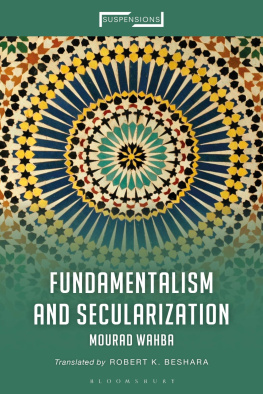Routledge Revivals
Holy Wars
To some, Islamic Fundamentalism means the restoration of a true religion. To others, it is a politics that stands apart from capitalism and socialism. To many Westerners, it has come to constitute a threat to established order and international security. Holy Wars, first published in 1989, comprises a non-partisan narrative that takes account of both the socio-cultural values expressed in Fundamentalism, and its political consequences. Dilip Hiros starting point is that fundamentalist forces have been active within Islam since the death of the Prophet Muhammad. He presents the two major sects, Sunnis and Shias, in this light. Hiro provides the background for an understanding of what was taking place in Middle Eastern countries such as Afghanistan, Libya, Egypt and Syria at the end of the 1980s. This is a comprehensive and readable work, of great relevance and value to those with an interest in Middle Eastern politics and history, and the growth of Islamic Fundamentalism.
Highly readable It is both a beginners guide and a highly intelligent wrap-up for the specialist - Ahmed Rashid, The Independent
Well-written, comprehensive, informed and, most important, carefully balanced and objectively presented - James A. Bill, The Washington Post
A welcome companion for those watching Islams struggle for balance between authenticity and modernity, which now affects us all - Publishers Weekly
A well-researched chronicle of its subject and a valuable insight into the movements impact - Marie Colvin, The Sunday Times
Holy Wars
The Rise of Islamic Fundamentalism
Dilip Hiro
First published in 1989
by Routledge, Chapman and Hall, Inc.
This edition first published in 2013 by Routledge
2 Park Square, Milton Park, Abingdon, Oxon, OX14 4RN
Simultaneously published in the USA and Canada
by Routledge
711 Third Avenue, New York, NY 10017
Routledge is an imprint of the Taylor & Francis Group, an informa business
1989 Dilip Hiro
The right of Dilip Hiro to be identified as author of this work has been asserted by him in accordance with sections 77 and 78 of the Copyright, Designs and Patents Act 1988.
All rights reserved. No part of this book may be reprinted or reproduced or utilised in any form or by any electronic, mechanical, or other means, now known or hereafter invented, including photocopying and recording, or in any information storage or retrieval system, without permission in writing from the publishers.
Publishers Note
The publisher has gone to great lengths to ensure the quality of this reprint but points out that some imperfections in the original copies may be apparent.
Disclaimer
The publisher has made every effort to trace copyright holders and welcomes correspondence from those they have been unable to contact.
A Library of Congress record exists under LC control number: 89010190
ISBN 13: 978-0-415-82444-6 (hbk)
ISBN 13: 978-0-203-38101-4 (ebk)
HOLY WARS
The Rise of Islamic Fundamentalism
by Dilip Hiro
Published in 1989 by
Routledge
An imprint of Routledge, Chapman and Hall, Inc.
29 West 35th Street
New York, NY 10001
Copyright 1989 by Routledge, Chapman & Hall, Inc.
Printed in the United States of America
All rights reserved. No part of this book may be reprinted or reproduced or utilized in any form or by any electronic, mechanical or other means, now known or hereafter invented, including photocopying and recording, or in any information storage or retrieval system, without permission in writing from the publishers.
Library of Congress Cataloging-in-Publication Data
Hiro, Dilip.
Holy wars : the rise of Islamic fundamentalism / Dilip Hiro.
p. cm.
Bibliography: p.
Includes index.
ISBN 0-415-90207-X. ISBN 0-415-90208-8 (pbk.)
1. Islamic fundamentalismMiddle EastHistory20th century.
2. Islam and politicsMiddle EastHistory20th century.
3. Middle EastPolitics and government. I. Title.
BP63.A4M534 1989
CIP
The Muslim World
Heartland of Islam
The Islamic calendar is lunar. It dates from 15 July A.D. 622, the day of the hijra (migration) of Prophet Muhammad from Mecca to Medina, and is denoted by A.H.: After Hijra.
On average a lunar year contains 354 days. The Islamic lunar months, with their duration, are: Muharram (30 days), Safar (29), Rabia Awal (30), Rabia Thani (29), Jumada Awal (30), Jumada Thani (29), Rajab (30), Shaaban (29), Ramadan (29), Shawal (30), Dhu al Qaada (29) and Dhu al Hijja (30).
Since a lunar year is shorter than a solar year by eleven days, it takes thirty-four years to equal roughly thirty-three solar years. That is, there is an approximate difference of three years between a lunar century and a solar one.
To convert an Islamic lunar year date to a Christian solar date, divide it first by 1.031, and then add 621 or 622.
aal: of a family or tribe
abi/abu: father
adha: sacrifice
ahl: people
akbar: great
akhbar: report
al/el/ol/ul: the
Alawi: follower or descendant of Imam Ali
alim (pi. ulama): religious-legal scholar
amal: hope
amr: command
ansar: helper (of Prophet Muhammad)
ashura: (lit.) tenth; (fig.) tenth of Muharram
asr: period or age
Ayatollah: sign or token of Allah
azhar: resplendent
baath: renaissance
bacha: son
bait: place or house
balaghe: eloquence
basij: mobilization
bast: sanctuary
beduin (sing, bedu): nomads
bida: innovation
bin: son
bint: daughter
bismillah: in the name of Allah
chador: (lit.) sheet; (fig.) veil
daawa: call (of Islam)
dar: house or realm
dervish: mendicant
din: faith
-e: of
eid: festival
Eid al Adha: the Festival of Sacrifice
Eid al Fitr: the Festival of Breaking the Fast
emir/amir: one who gives amr (command); commander
faqih: religious jurist
fatwa: religious ruling
fedayin (sing. fedai): self-sacrificers
fitna: sedition or civil strife
fitr: breaking the fast
hadd: (lit.) boundary; (fig.) punishments contained in the Sharia
hadith: action or speech of Prophet Muhammad or an Imam
hajj: pilgrimage (to Mecca)
haram: religiously forbidden
harb: war
hazrat: title for a prophet or imam
hijab: screen or veil

















